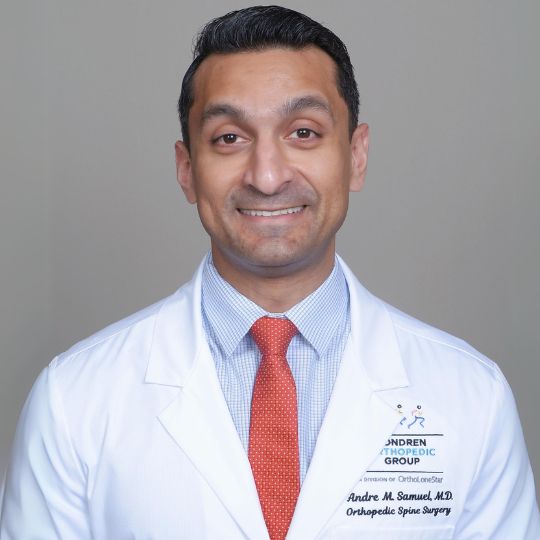Neck and Spinal Revision Surgeon
If you are dealing with a complicated spine issue or a failed surgery in the neck or upper back, it is crucial to see an experienced surgeon. Dr. Andre M. Samuel, specializes in complex revisions, especially after failed hardware or failed surgery. He serves Clear Lake, Houston, and Sugar Land, TX and can help you with a complex revision cervicothoracic reconstruction. He and his stall offer the expert care you need. Contact Dr. Samuel’s team today!

What is complex revision cervicothoracic reconstruction?
Complex Revision Cervicothoracic Reconstruction is a surgical procedure to correct severe problems in the cervicothoracic region of the spine. This area is where the cervical spine meets the thoracic spine. It helps correct a hardware failure from a previous surgery or a spinal deformity, such as inability to hold one’s head upright. The surgery can address spinal issues such as tumor removal, infection, or trauma. These factors can severely destabilize the spine, making revision surgery essential for restoring stability and function. Due to the difficult nature of this surgery, it must be performed by an experienced surgeon. Doctor Andre M. Samuel, orthopedic spine surgeon, treats patients in the Clear Lake, Houston, Sugar Land, TX area who may need complex revision cervicothoracic reconstruction.

Who are the best candidates for complex revision cervicothoracic reconstruction?
Complex revision cervicothoracic reconstruction is strictly for patients with serious spinal issues such as:
- Hardware failures from previous surgery
- Significant spinal deformities such as scoliosis or inability to hold head upright
- Persistent pain or neurological symptoms
- Spinal instability
A consultation with Dr. Samuel is essential to explore whether this complex surgery is the right option.
How is complex revision cervicothoracic reconstruction performed?
Complex revision cervicothoracic reconstruction can be performed, in one of three ways – depending on the patient’s specific needs.
Anterior Approach:
- Samuel accesses the spine with an incision in the front (anterior) of the body – specifically in the neck or the upper chest. This makes it easier for him to make certain corrections and reduces the risk of muscle damage.
Posterior Approach:
- The posterior approach involves an incision along the back’s midline to access and stabilize the spine. This is helpful in complex reconstructions where rods and screws are needed across multiple levels. Additionally, the posterior approach is ideal for those patients with spinal tumors and infections.
Combined Anterior-Posterior Approach:
- Sometimes, Dr. Samuel uses a combined anterior-posterior approach to provide comprehensive correction and stabilization. By accessing the spine from both the front and back, he can remove discs and place grafts through the front, while the posterior approach allows for securing the spine with rods and screws. This method is typically reserved for the most challenging cases, such as severe scoliosis, multi-level hardware failures, or when extensive reconstruction is required due to previous surgeries or trauma.
Minimally Invasive Techniques:
- In certain situations, Dr. Samuel uses a minimally invasive surgical technique to perform the reconstruction. This is ideal for patients with isolated hardware failure or minor spinal deformities. However, not all patients are candidates for this approach which helps reduce pain and hospital stays.
How long does it take to recover from complex revision cervicothoracic reconstruction?
Recovery from complex revision cervicothoracic reconstruction varies depending on the patient’s health and the complexity of the surgery. A patient may spend a few days in the hospital following the procedure, before going home. Most patients can start walking within a few days, while a full recovery takes around 3 to 6 months.
While healing, patients should be cautious about returning to normal activities too soon, as rushing recovery can risk further complications. Post-surgical checkups are critical to monitor the healing process, and adjustments to the recovery plan might be needed to ensure the best outcome.


